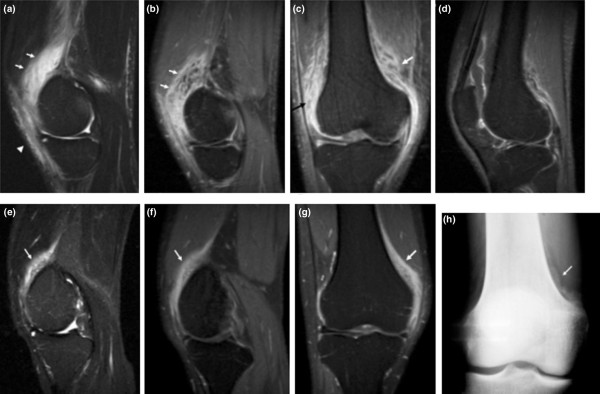Figure 2.

Early and late magnetic resonance imaging (MRI) findings of heterotopic ossification (HO). HO in the right knee of a 35-year-old male patient hospitalised in the intensive care unit for traumatic brain injury. (a-d) First MRI performed on clinical suspicion of HO. (a) Sagittal fast spin-echo short inversion-recovery MR image (3,000/80; inversion time, 165 milliseconds) shows high signal of the innermost part of the vastus medialis muscle (arrows) and edema of the subcutaneous fat (arrowhead). (b) Sagittal contrast-enhanced fat-suppressed T1-weighted spin-echo MR image (650/17) shows a 'lacy pattern' of the innermost part of the vastus medialis muscle (arrows). (c) Coronal contrast-enhanced fat-suppressed T1-weighted spin-echo MR image (650/17) shows a 'lacy pattern' of the innermost part of the vastus medialis muscle (white arrow) and vastus lateralis muscle (black arrow). (d) Mid-sagittal contrast-enhanced fat-suppressed T1-weighted spin-echo MR image (650/17) shows joint effusion and synovial enhancement. (e-h) Follow-up MRI (e-g) and x-rays (h) performed 3 weeks later. (e) Sagittal fast spin-echo short inversion-recovery MR image (3,000/80; inversion time, 165 milliseconds) shows heterogeneous high signal of the innermost part of the vastus medialis muscle (arrow). Sagittal (f) and coronal (g) contrast-enhanced fat-suppressed T1-weighted spin-echo MR images (650/17) show heterogeneous enhancement of the innermost part of the vastus medialis muscle (arrows). (h) Anteroposterior x-ray depicts a calcified mass at the anatomic position of the vastus medialis muscle (arrow).
